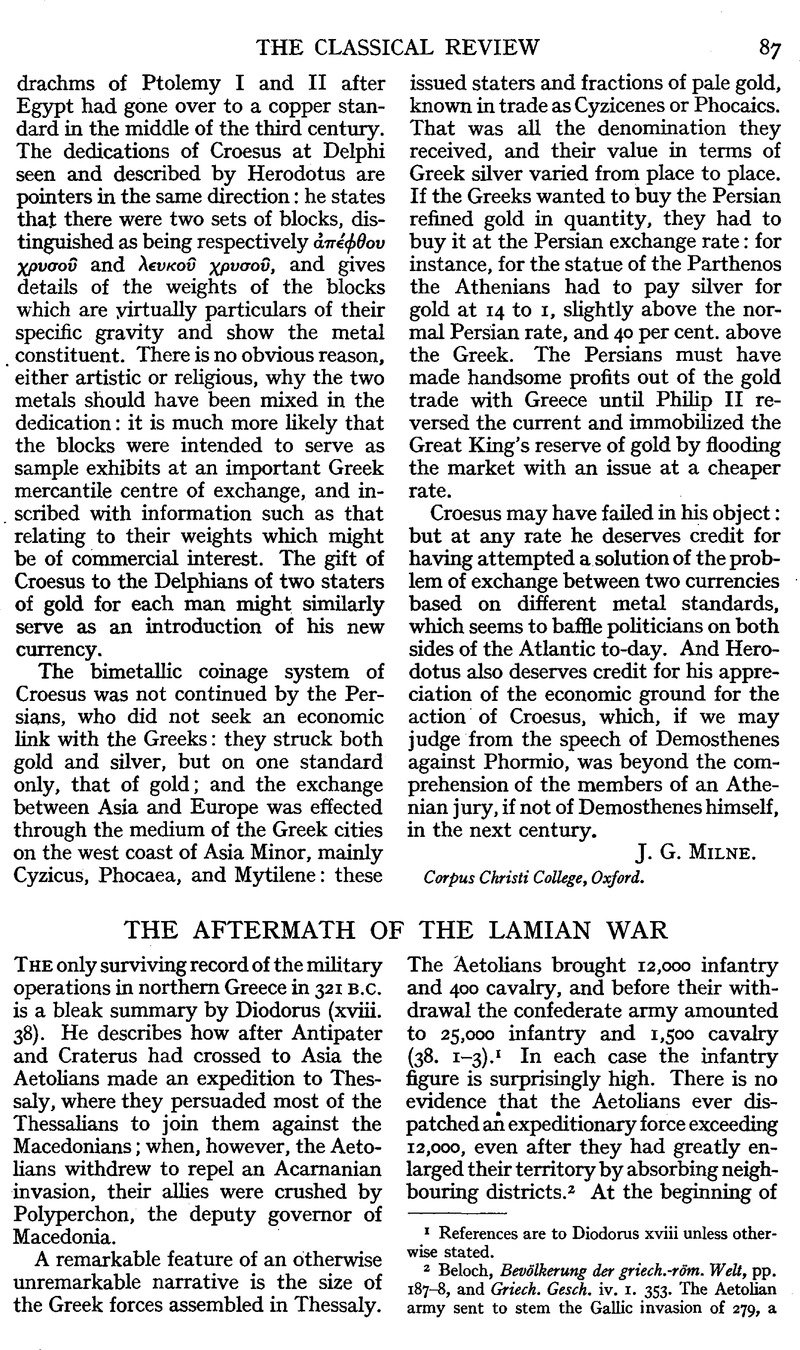No CrossRef data available.
Article contents
The Aftermath of the Lamian War
Published online by Cambridge University Press: 27 October 2009
Abstract

- Type
- Review Article
- Information
- Copyright
- Copyright © The Classical Association 1949
References
page 87 note 1 References are to Diodorus xviii unless otherwise stated.
page 87 note 2 Beloch, , Bevölkerung der griech.-röm. Welt, pp. 187–188Google Scholar, and Griech. Gesch. iv. I. 353. The Aetolian army sent to stem the Gallic invasion of 279, a crisis of exceptional gravity, possibly exceeded 12,000 (the text of Paus. x. 20. 4 is defective), but there is no adequate reason for believing that it did (Tarn, , C.A.H. vii. 102Google Scholar. Flacelière, , Les Aitoliens à Delphes, p. 96Google Scholar, n. 1, is unconvincing).
page 88 note 1 Schwahn, , Heeresmatrikel und Landfriede Philipps, p. 8Google Scholar, rejects it as false.
page 88 note 2 The Greeks had 22,000 infantry against Leonnatus (15. 2) and 25,000 at Crannon (17. 2). Of these at least 10,000 were mercenaries and 5,000 Athenians (9. 1, 11. 3), so that the contributions of Thessaly, Phocis, and other northern districts must have been modest.
page 88 note 3 I have maintained elsewhere that in the Lamian war Thessalian support for the Greek cause was by no means unanimous (Thessafy in the Fourth Century B.C., p. 231). Some additional points may be noted here. Diodorus (II. 1–2) and Pausanias (i. 25.4) give impressive lists of allies, but the figures given in n. 2 above show that many supplied little or no military aid. To encourage waverers the Athenians evidently counted as allies all states not controlled by Macedonian garrisons or not expressly hostile to Athenian diplomatic missions. The statement that all Thessaly except Pelinna joined the alliance (II. I) seems to mean only that Pelinna was garrisoned by the Macedonians. The insurrection was probably confined to Pharsalus, Pherae, and the south: that Larisa, which was in a dangerously exposed situation, contributed to the allied army is unlikely. The number of cavalry (5,000) on the Macedonian side at Ciannon (16.5) exceeds the separate figures for the cavalry forces of Antipater, Leonnatus, and Craterus (3,600 in aggregate, 12. 2, 14. 5, 16. 4) despite casualties in earlier battles. Diodorus may have omitted to mention the arrival of some cavalry reinforcements, but it is not improbable that some Thessalians remained loyal to Antipater and fought against their compatriots.
page 88 note 4 Cf. Ζετταλο⋯ π⋯ντες πλ⋯ Πελιννα⋯ων(II. I) with τοὺς πλε⋯οτους τ⋯ν Ζετταλ⋯ν ἔπεισαν κοινωνεῖν (38.3), both statements being exaggerated through the influence of contemporary propaganda.
page 88 note 5 Op. cit., p. 234, n. 2; cf. the army of Jason discussed ibid., pp. 104–12.
page 88 note 6 8,000 under Leosthenes (9. 1), 2,000 sent with the Athenian citizen army (II. 3), and perhaps a few more contributed by allied states.
page 88 note 7 The Greek losses at Crannon were only 500 (17.5, cf. Plut. Phoc. 26. 1), while the battle against Leonnatus was almost exclusively a cavalry engagement (15. 3–4).
page 89 note 1 Diod. xvii. III. 1–2, and xviii. 9. 1; Paus. i. 25. 5, and viii. 52. 5.
page 89 note 2 Thessalian towns besieged by the Macedonians received no aid (17. 7).
page 89 note 3 Griffith, , Mercenaries of the Hellenistic Age, p. 36Google Scholar.
page 89 note 4 Griffith, op. cit., pp. 259–60.
page 89 note 5 That any were among the 2,500 enlisted by agents of Thibron for service at Cyrene (2I. 1–2) seems to be excluded on chronological grounds: these men almost certainly left Taenarum before the end of the Lamian war.
page 89 note 6 The alliance with Perdiccas has not been mentioned before (and is not mentioned again); the use of the definite article suggests that Diodorus has omitted details about its formation given earlier by his source.
page 89 note 7 Sanctis, De, Problemi di Storia antica, p. 142Google Scholar.
page 89 note 8 Diversionary action to distract an enemy from the main theatre of war became a feature of the struggles between the Successors. It was much used by Antigonus: his alliance with the Aetolians in 315 was part of such a diversion directed against Cassander, but, unlike Perdiccas in 321, he had prospects of gaining more powerful allies. He sent to Greece a diplomatic agent, who enlisted 8,000 mercenaries, probably at Taenarum.
page 90 note 1 оί Πоλιтικоι can be used as the opposite of οἱ σ⋯μαχοι or of оί χένоι, but it is significant that in describing the armies of the Lamian war Diodorus (II. 3) contrasts πολιτικο⋯ς μ⋯ν with μισθοφ⋯ρους δ⋯ and Hyperides (vi. II) ξενικ⋯ν μ⋯ν δ⋯ναμιν with τ⋯ς δ⋯ πολιτικ⋯ς (cf. the observations of Tarn, , Alexander, ii. 169, n. 2 on 12. 2Google Scholar; also Dem. xviii. 237).
page 90 note 2 His daughter married Aeacides of Epirus and became the mother of Pyrrhus (Plut. Pyrrh. I. 6–7).
page 90 note 3 If more were known about the Carthaginian of Menander and its relation to the Poemdus of plautus, which has Aetolia for its setting, some light might have been thrown upon the episode discussed above. Webster, , Rylands Bulletin, xxx (1947), p. 54Google Scholar, gives reasons for believing the Carthaginian to have been an early play and suggests that the choice of scene may have been determined by contemporary history. After 317, when Demetrius of Phalerum, the friend of Menander, became governor of Athens for Cassander, the Aetolians cannot have been in favour there, but during the preceding years many Athenians who, like Demades, hoped to turn the conflicts of the Successors to account doubtless felt sympathetic towards Aetolia.




